#Protar
Explore tagged Tumblr posts
Text

Cover of the Day: Defenders #76 (October, 1979) Art by Rich Buckler, Al Milgrom, George Roussos, Irv Watanabe
#Marvel#Comics#Defenders#Hulk#Omega the Unknown#Dibbuk#Ruby Thursday#Valkyrie#Hellcat#Patsy Walker#Protar
32 notes
·
View notes
Note
Fic authors self rec! When you get this, reply with your favorite five fics that you've written, then pass on to at least five other writers. Spread the self-love ❤
Thank you for this, @irregularcollapse! (My notes here are mostly what prompted me to write what I did.)
"Bet Your Pain on that Lonely View" - Kiznaiver, Multi-Ship (Poly)
The show was a lot, so it felt necessary to give a bit of closure that was... Quiet. These are all characters who, by design, had big personalities. I wanted to write them trying to navigate their relationships post-canon, without the weight of the plot looming over them.
"The Weight of It" - FE:3H, Caspar/Linhardt
Previously titled "Protare (to carry)." The PoV character was very outside of my wheelhouse, but it always felt like he (and his relationships) had more depth than it first appeared. This whole fic also may have been an excuse to write about the effects that magic theoretically could have, especially scarring.
"soft, like a body" - Rain World, Gen
Rain World lore is dense, but the draw of writing this was the characters themselves; two gods of opposing temperament existing in a world that outgrew them both. Writing this came very naturally, if only because it is 2,000 words worth of existentialist musings by a supercomputer. In retrospect, I probably was just possessed by the spirit of Asimov.
"The Fatalist Circuitry of Veins" - MDZS (CQL), Mian-Mian/Wen Qing
To tell the truth, Mian-Mian had such a big presence in a small role—it felt a bit like a missed opportunity to me. Similarly, I disliked how sidelined the Wens were in so many fix-it fics for this fandom. This was just a case of writing what I wanted to see in the world, which is in part: More Women.
"Familiar Patterns to Absence" - MDZS (CQL), Wen Qing/Jiang Yanli
A modern + soulmate AU where the word "Soulmate" is never actually used. The concept, being tethered to someone by finding the objects they lose, was striking, and it kills me a bit that I cannot find the post which instigated it. This piece also ended up using tactility in a way that pleases me, at least in retrospect.
#fic#fanfiction#my writing#writeblr#kiznaiver#fire emblem#fe:3h#rain world#mdzs#mo dao zu shi#cql#tagging the pov characters. eheheheh.#yoshiharu hisomu#caspar von bergliez#looks to the moon#luo qingyang#wen qing
2 notes
·
View notes
Text
Attraversare il craving
Nella mia esperienza, le volte che è stato più drammatico è quando sentivo l'irrefrenabile voglia di farmi del male, mordermi, graffiarmi e tirare le testate al muro per far cessare le voci che mi infilzavano la mente come lance appuntite. come lame taglienti.
Restare lì, nel mezzo di un attacco di panico e resistere alla voglia di farmi del male, è la cosa che mi ha fatto provare più paura dell'attacco di panico stesso. E' come guardare negli occhi il mostro più terrificante che tu possa immaginare; in quei momenti senti tutta la disperazione e il dolore che provi per te stesso. In quesi momenti ho davvero capito cosa significa provare compassione per sè stessi.
Sentire le mani che fremono, lasciarsi attraversare dalla voglia di dilaniare se stessi, da quel bisogno folle, che sai che è sbagliato e ti senti già in. Colpa al solo pensarlo, di volerti fare male. Di cedere. Come quando sai già di essere dipendente da una cosa, una sostanza, l'alcol o da un gesto. Dall'emozione che porta, anche se è un'emozione di merda.
Attraversa il craving. Presta ascolto alla brama.
Ho sviluppato una strategia: occupare le mani con qualcosa, che sia tamburellare freneticamente sul tavolo le dita, scrivere o dipingere, prendere il guinzaglio e protare a spasso il cane.. tenere le mani occupate fino a quando il panico si sgonfia.
"Torna al corpo"
Si lo so sembra la massima di uno Jedi e forse un po' è così.
È scritto un po' ovunque nell tradizioni sapienziali di ogni dove: torna al corpo. Respira, nota l'aria che entra e esce dalle narici, non pensarlo e basta. Senti la sensazione del tatto, presta attenzione ai rumori intorno. Rientra in te stesso. Un attimo di concentrazione dopo l'altro fino a quando il panico si sgonfia
Perché si sgonfia, come un palloncino
Vedi mai che nel mentre lo attraversi, il craving, hai anche una bella intuizione. Hai stanato il condizionamento nel bel mezzo di un triplo tornado
Pensi di non essere capace, pensi che non ce la fai e invece ci stai e ne esci.

2 notes
·
View notes
Text
The Last Naturalists’ Graflex Ever Made – Thomas Evans
The Last Naturalists’ Graflex Ever Made – Thomas Evans
Published in the Graflex Journal, 2023, Issue 1.

The Naturalist Graflex was introduced in 1907, and was produced until 1921. The 1907 Graflex Catalog described the concept behind this unusual design very well:
“The Naturalists’ Graflex Camera is designed especially for naturalists’ work in photographing birds, wild animals, or similar subjects where long-focus or tele-photo lenses are required. The camera in general design and construction is similar to the regular Auto Graflex, but the increased length of the camera accommodates much longer side arms. These arms are made of heavy brass, giving ta liberal extension, yet maintaining absolute rigidity. The focus is obtained by reflection on the upper mirror, and enables the operator to conceal himself behind a stone or log and focus from the rear of the camera without exposing too much of his person, as would be the case in using the ordinary type of Graflex Camera.”
“The Naturalists’ Graflex will accommodate lenses of from 12 ¾ to 26 inches equivalent focus, and is fitted with the regular Graflex Focal Plane Shutter.”
The camera without lens, including one double plate holder was priced at $190.00. The camera with the Bausch & Lomb Zeiss Protar Lens, Series VIIa, No.19, f6.3, was twice as expensive, priced at $378.50. This Protar VIIa lens had a focal length of 13 ¼-inches (336.5mm), and was a combination of two Protar VII lens components of 23 1/8-inches (590.5mm) each. The Protar Lenses were designed to be used in combination, at f/6.3, or each component could be used singly, usually at about f/12.5. And so, this lens could be used at either 13 ¼-inch or 23 1/8-inch focal length. Zeiss, and Bausch & Lomb under contract, made Protar lenses in several focal lengths, and, in theory, some different Protar VII lens components and combinations could be used with this camera.
The 1920 Bausch & Lomb catalog said this about their Protar VIIa lenses:
“The series VIIa lens has satisfactorily solved the problem of variety and convenience; for composed as it is of two series VII single Anastigmats, the doublet resulting from the combined components is simply perfection in all the qualities desired in a photographic lens.”
“As single Anastigmats, the Series VII lenses have a distinct field of their own. They are perfect single lenses, having a speed of F:12.5, which is ample for instantaneous exposures out of doors under favorable light conditions. So perfect are the spherical and astigmatic corrections as to make the single lens almost equal to the doublet, and not only equal, but actually superior to many doublet lenses of other makers…”
In the 1908 catalog, the Naturalists’ Graflex had a new feature: the view finder could be rotated from horizontal to vertical, to allow focusing from the ordinary Graflex position.
The Folmer & Schwing Division offered to fit the customer’s own lens to their cameras. Mike Hanemann, in his first-quarter 2001 Graflex Historic Quarterly article, described a Naturalists’ Graflex that had been fitted with an f:5.6, 20-inch Taylor Telephoto lens, and due to the quality of the workmanship he thought that it must have been done by the factory. The modification involved cutting away the top of the lens box to make room for the lens and to allow access to adjust the lens aperture.
Frank M. Chapman
Frank Chapman, ornithologist and Bird Curator at the American Museum of Natural History, New York City, was an early user of the Naturalists’ Graflex. Mr. Chapman may have been a significant inspiration for the design of this camera. In his 1903 book, “Bird Studies with a Camera”, he described his ideal apparatus for making photographs of birds, which would be a 4x5-inch ‘reflecting’ camera,’ with “… a mirror, set at an angle of forty-five degrees to the plate, is interposed between the latter and the lens, and reflects the image to a ground glass on top of the camera… The mirror, when released, should automatically release a focal plane shutter. Mr. Chapman also recommended that the bird photographer use a convertible Zeiss Anastigmat (Protar), Series VIIa lens, in order to have at hand both a fairly fast normal lens and a lens of about twice the focal length when a single component lens was used. The Naturalists’ Graflex appears to have been designed to make the best use of the B&L Convertible Protar No. 19, as it accommodates both the combined focal length of 13 ¼-inch and the single element focal length of 23 ¼-inch, which are very close to the minimum and maximum focal lengths that can be used with this camera.
In his 1933 Autobiography of a Bird Lover, Mr. Chapman reflected back on his early experiments at bird photography: “There were no reflecting or Graflex cameras available for our work in Florida, and the naturalist photographer was handicapped by the lack of a camera carrying a long-focus lens with which, without pausing to insert a plate, he could make an exposure at the moment of focus.” The camera that he first tried was made for him by John Rowley who worked with him at the museum, which was a 5x7-inch twin-lens-reflex camera, which he described as cumbersome but practical. I suspect that a Naturalists’ Graflex, as large as they were, would seem quite trim and nimble in comparison to this camera.
Frank Chapman was the editor of the Bird Lore Magazine, published under the auspices of the National Association of Audubon Societies, and in the March – April 1908 issue, he included a recommendation for the Naturalists’ Graflex, quoting substantially from the Graflex catalog. This prominent recommendation may have been sought-after by Folmer & Schwing, and must have been much appreciated by the company. As a possible measure of Mr. Chapman’s influence, he was an associate of then President Theodore Roosevelt, and the Naturalists’ Graflex page from the 1908 catalog is among Mr. Roosevelt’s papers.

Naturalists’ Graflex page from Roosevelt’s papers.

Ad for the Naturalists’ Graflex in Bird Lore Magazine.
In the introduction of Mr. Chapman’s 1908 book, Camps and Cruises of an Ornithologist, he described his photographic outfit: “I still use a reflecting camera of the ‘Graflex’ type, and also a tripod camera … a Bausch & Lomb Convertible Series VIIa No. 10, F. 6.3, with a focal length of eight inches, the component lenses having each a focal length of fourteen inches. Although these single lenses are rated with a speed of only F. 12.5, I have found no difficulty in making satisfactory pictures of birds in flight with an exposure one-thousandth of a second, the lens being wide open. … if one can afford a No. 19 lens of the same series with a focal length of thirteen and one-eighth inch focus, the components being each of twenty-three and one-eighth inch focus, he will materially increase his chances of success…” In this book, he mentions using the 23-inch Protar single component lens for photographing birds at greater than 50 yards.
Arthur Radclyffe Dugmore
A Radclyffe Dugmore was another prominent photographer of birds and wildlife who may have had some influence on the design of the Naturalists’ Graflex. As early as 1902, the year that the very first Graflex Camera was introduced, he had praise for the camera: “… The Graflex, which, though expensive, is about all that can be wished for. Being strongly made, it will withstand the rough usage incidental to natural-history photography. Its ling draw of bellows allows of the use of a twelve-inch lens, and for objects up to within about ten feet distant a six-inch lens with hand-camera telephoto attachment can be used. … A bird may be caught on the wing with as much ease and certainty as if it were mounted.”
He goes on to describe his preference in lenses: “The most useful lens for all-round work is one whose two systems or combinations can be used separately. By having such a lens you have practically two in one, the single combination having about double the focal length of the couplet.”
In a latter book, Mr. Dugmore says: “The reflex camera should be so arranged that the focussing hood admits of use from above and from the back. The advantage of this is that it allows the camera to be held level with the eyes so that the immediate foreground is not shown in the picture. When you are in a canoe you can operate this camera with greater freedom and safety as it will not be necessary to stand up or even to kneel in order to clear the adjacent water or the canoe bow which so often obtrudes itself in such pictures.”
I don’t know how closely Mr. William Folmer read such books and magazines by naturalist photographers, looking for ideas, but if he did, the desires of these photographers were there to find and inspire his designs.
Production
Despite its wonderful design and promotion, it appears that the total number of Naturalists’ Graflex Cameras made would be less than 200. There is no existing record of the cameras made from 1907 to 1914, but the existing records do show that 61 4x5-inch Naturalists’ Graflex Cameras, and one 5x7-inch model, were made from 1915 to 1921. If the rate of about nine cameras per year had been held in the first eight years of production, then that would bring the total to about 130 cameras, but there is really no way to know for sure.
Naturalists’ Graflex production orders from the extant serial number book: [61: 4x5” and 1: 5x7”]
Lot Amt. Camera Serial numbers Location
6671 18 4x5 Naturalists’ Graflex Cameras 56760 – 56977 [sheet 4, c.1915]
6677 18 4x5 Naturalists’ Graflex Cameras 76988 – 77005 [sheet 5]
5801 1 5x7 Naturalists’ Graflex Camera 111700 [sheet 17]
6845 12 4x5 Naturalists’ Graflex Cameras 111751 – 111762 [1920 – 1921]
6845 13 4x5 Naturalists’ Graflex Cameras 111787 – 111799 [1920 – 1921]
According to Al Benham’s article: Rural Life Photographer, in the Graflex Journal, Issue 1, 2017, his grandfather, John Calvin Allen, had the 5x7-inch Naturalists’ Graflex, 111700, made-to-order to use to photograph individual beef animals where a long-focus lens must be used to avoid distortion. J. C. Allen wrote of this camera: “The camera will accommodate a 23-inch lens and is focused through a reflector, so the animal is seen on the ground glass until the exposure is made. This is quite an advantage with restless animals, especially in fly time.” Mr. Allen had a rural photographic business in Indiana, as well as running his own farm, and working for a while for Purdue University.
Assuming that the existing production orders were accurate, then the Naturalists’ Graflex Camera that I have, number 111799, was the last one ever made.

Naturalists’ Graflex showing the view finder in horizontal position.
The Last Naturalists’ Graflex

Bausch & Lomb f:6.8, 24-inch, Telestigmat lens.
The camera arrived with some damage, but in overall very good condition. The slide that holds the lens in place on the front standard had come loose, the screws had pulled out, and this heavy lens had apparently banged around in the lens box, splitting the wooden sides of the box. This was fairly easy to repair, and once the focal plane shutter had been lubricated and exercised a bit, the camera works well. The lens is not the B&L Zeiss Protar VIIa No.19, but is instead a Bausch & Lomb 24-inch, f:6.8 Telestigmat. It is a large piece of glass, weighing 4 pounds. The lens board is a hefty 3/8th inch thick, with no step around the edges, and is just under 4 ½” square.
The 1917 Graflex catalog still lists the Protar VIIa No. 19 lens for the Naturalists’ Graflex, but the 1919 catalog lists this 24-inch Telestigmat in its stead. Carl Zeiss Optical Works and Bausch & Lomb had entered into a collaboration in the 1890s under which B&L was licensed to produce lenses according to the Zeiss optical designs, but this corporate alliance ended during World War I. The Telestigmat is marked “Pat. Oct. 24, 1918,” and so was developed during World War I, apparently to be used for aerial reconnaissance. As B&L was no longer under license to Zeiss to make the Protar lenses, a new lens was needed, and the Telestigmat would have been an appropriate and readily available substitute.
In his book “Flight, Action, Camera,” Douglas E. Campbell mentions that in September 1921, the U. S. Navy conducted tests of the 24-inch B&L Telestigmat for use in aerial mapping. Curiously, the Navy concluded that this 24-inch lens did not adequately cover the 4x5-inch format. Later, during World War II and into the 1950s, the U. S. Military did use a B&L 40-inch, f:8 Telestigmat, for aerial reconnaissance, and to photograph nuclear tests.

A second mirror reflects the ground glass image to the view finder when used in the horizontal position.
Using The Naturalists’ Graflex
The Naturalist Graflex does not have a revolving back, and the film is held in the landscape position. The view finder stores away compactly when not in use, and can be used from the rear as well as from the top. When used in the horizontal position, a second 45-degree mirror reflect the image from the ground glass back through the view finder. The main body of the camera is seven inches tall by seven inches wide, including the shutter controls, and eighteen inches long. The view finder at the rear of the camera brings the height to twelve inches, and when opened for viewing it reaches sixteen inches tall when vertical. The view finder adds eight inches to the length when horizontal, reaching twenty six inches. So, the camera is roughly three times the length of the standard 4x5-inch Auto Graflex, or about twice the length of the RB Auto Graflex. When the 24-inch Telestigmat is focused at infinity, because it is a telephoto lens it only needs to be extended three inches beyond the front of the camera, and at this focus the camera is well balanced and easy to use hand-held. However, as one focuses on nearer subjects the camera becomes quite front-heavy. When the bellows is fully extended, the camera will focus on a subject at nine and one-half feet, but the camera is then thirty-one inches long, not counting the view finder if horizontal. At this closest focus the camera is unwieldy hand-held, and it is a challenge to use even on a sturdy tripod. Used on a heavy tripod, this closest focus produces an image on the film that covers an area one foot wide.
Conclusion
The Naturalists’ Graflex is an extraordinary and fascinating camera. It was designed in 1907 with the special needs of the then pioneer naturalist photographer in mind. That is, the field-going photographer needed a portable, hand-held camera that would be self-contained and yet versatile enough to not only allow up-to-the–moment-of-exposure focusing, full image viewing on a ground glass, and shutter speeds of up to 1/1000th second to catch quick movement, but which would also accommodate telephoto and long-focus lenses so that the photographer could secure detailed images of birds and other wildlife, or similarly unapproachable subjects, from a distance. The long-focus lenses also proved to be useful for producing distortion-free images such as were valuable for scientists and commercial photographers. This camera for-shadowed the development of later long-focus cameras such as the Big Bertha.
Being a large and somewhat unwieldly, and expensive, camera probably kept it from being more widely appreciated, but it was well designed for the narrow purpose for which it was intended. Sales were never high, and this plus the loss of the ability of Bausch and Lomb to continue to manufacture the Protar Ser. VIIa lenses, for which the camera appears to have been designed, probably led to the camera being discontinued.
Today, a hundred years after the Naturalist Graflex was discontinued, it is hard to imagine hauling so much camera around while on safari, exploring the swamps of Florida, mountain climbing, or just walking down to the local park. The quality and unimaginable quantity of telephoto and zoom lenses now available for small cameras that produce high resolution images at the touch of a button have removed the need for packing such a large camera, but they have not removed the fascination.

U.S. Army Signal Corps during WWI with a Naturalists' Graflex among other cameras, curtesy of De Miollis Laurent.
Bausch & Lomb Optical Company, 1920 Photographic Lenses. (Pages 37, 58)
Benham, Al. 2017. Rural Life Photographer. Graflex Journal, Issue 1, 2017. (Page 4) (5x7 Naturalists’ Graflex) Available here: https://journal.graflex.org/journal-2017-01.pdf
Campbell, Douglas E. 2014. Flight, Action, Camera, History of U. S. Naval Aviation Photography and Photo-Reconnaissance. Lulu.com (page 59.)
Chapman, Frank M. 1903 Bird Studies with a Camera, with introductory chapters on the outfit and methods of the bird photographer. D. Appleton and Company, New York.
Chapman, Frank M. 1908. Camps and Cruises of an Ornithologist. D. Appleton and Company, New York.
Chapman, Frank M. 1908. Bird Lore Volume X, No. 2. D. Appleton & Company, Harrisburg, PA, New York, NY.
Chapman, Frank M. 1933. Autobiography of a Bird Lover. D. Appleton – Century Co., New York, London.
Dugmore, Arthur Radclyffe. 1902. Nature and the Camera. Doubleday, Page & Co. New York. (Pages 4, 7)
Dugmore, Arthur Radclyffe. 1912. Wild Life and the Camera. J. B. Lippincott Company, Philadelphia, William Heinemann, London. (Page 21)
Graflex and Graphic Cameras, 1907. Folmer & Schwing Co. Rochester New York.
Graflex and Graphic Cameras, 1917. Folmer & Schwing Department, Eastman Kodak Co. Rochester New York.
Graflex and Graphic Cameras, 1919. Folmer & Schwing Department, Eastman Kodak Co. Rochester New York.
Anonymous, (Todd Gustavson?) 2014. The Mystery 5x7 Naturalists’ Graflex, Graflex Historic Quarterly, Volume 19, Issue 2, Second Quarter 2014. (Page 4) Available here: https://ghq.graflex.org/GHQ-19-2.pdf
Hanemann, Mike. 2001. The Graflex Naturalist Camera, Graflex Historic Quarterly, Volume 6, Issue 1, First Quarter 2001. (Page 1).
Harvard University, Collection of Historical Scientific Instruments,
Triple Alliance: Zeiss - Bausch & Lomb – Saegmuller 1908 1915.
http://waywiser.fas.harvard.edu/people/7108/triple-alliance--zeiss--bausch--lomb--saegmuller?fbclid=IwAR07OQmicaoaXid-2tisH839zB1CdIgLh9ROwmMOyufgNKuGo8C2P4RHmGA
Theodore Roosevelt Digital Library TR Center - Print Image (theodorerooseveltcenter.org)
Tuttle, Ronn. 2004. Special Find. Graflex Historic Quarterly, Volume 9, Issue 4, 2004. (Page 4)(The Long Focus Graphic)
Tuttle, Ron. 2015. Two Naturalists’ Cameras. Graflex Journal, Issue 3, 2015. (Page 1) Available here: https://journal.graflex.org/journal-2015-03.pdf
Wikipedia Frank Chapman, Ornithologist https://en.wikipedia.org/wiki/Frank_Chapman_(ornithologist)
Wilson’s Photographic Magazine, 1913, Volume 50, page 316

1908 Kermit Roosevelt with Naturalist Graflex in Africa
4 notes
·
View notes
Text
P-039 1/9 Norton Manx 500cc Chain Parts
Today, I'm introducing a new product, "P-039 1/9 Chain Parts for Norton Manx 500cc".
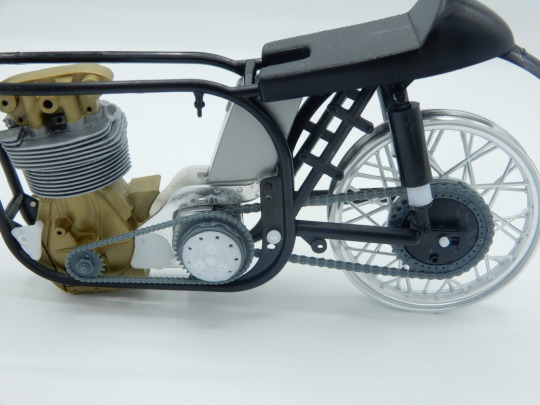
This is a chain parts set for Italeri's 1/9 Norton Manx 500.
As you can see, this bike is chain-driven in two places, from the engine to the gearbox and from the gearbox to the wheels. I think old Harleys were like this too.

As always, the parts are made up of separate parts such as the chain and sprockets. The image is a prototype from a while ago, so it is not shown, but I have included a few extras such as engine bolts for added detail.
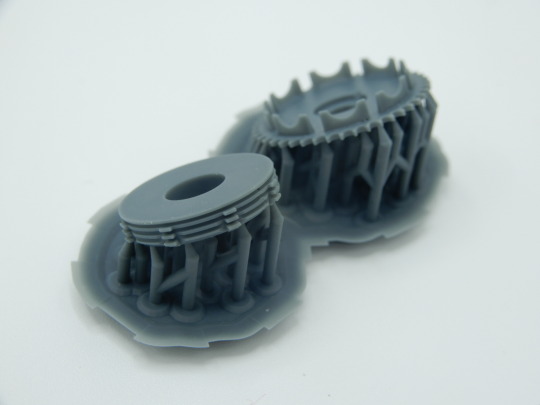
This bike is quite different from the original, so I have not been able to find the one that became the base for the kit. Some of the clutches are different from the ones in the image, but I tried to make it based on the ones I selected from images that look like they were from back then.

This is the first time I've put this kit together, but considering the size of the box, the contents are surprisingly neat.
It doesn't have too many parts, but it's an old kit with a fun and elaborate structure.
It's now Italeri, but it was originally a kit from a manufacturer called Protar.
I also have a Matchless, and the chain parts on that kit were made of a rubber-like material.
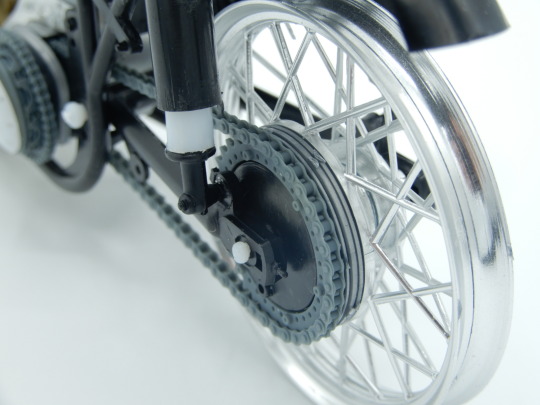
The sprockets also vary from one to another, but this one was made with a similar detail to the kit.
If you look around, you'll find many different ones, so it might be interesting to try making one using them as a motif.
The product page is here.
I've finally calmed down a bit with the preparations for the release, but I need to make some time to make the wheels.
I'm planning to release it in the middle of this month.
It's sold on the "SMC-Zero (Yahoo! Shop)" and "SMC/YATAGARASU (BASE/for overseas Japan)" sites, and I'm also thinking of using BOOTH from this year.
I'll add any updates here.
Well then.
Please support the 1/12 Z1000R1 injection kit.
・Patreon patreon.com/SMC9999
・Buy Me A Coffee https://www.buymeacoffee.com/smc9999
・Ko-fi https://ko-fi.com/smc9999
0 notes
Text
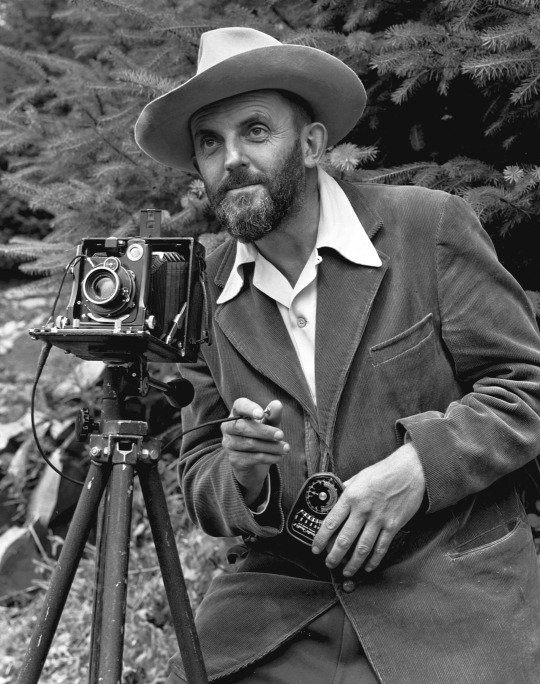
Photographic portrait of nature photographer Ansel Adams — which first appeared in the 1950 Yosemite Field School yearbook. The camera is probably a Zeiss Ikon Universal Juwel.
Ansel Adams is one of the giants of 20th Century photography, esteemed for his lush gelatine silver photographs of the national parks that have become icons of the US wilderness. A passionate champion of photography as a legitimate form of fine art, he referred to his most stunning images as his "Mona Lisas". But Adams was also a tireless conservationist and wilderness preservationist who understood the power of a strong image to sway public and political opinion.
His stirring images of US national parks have no doubt always inspired a desire to protect the natural world. But his lesser-known images of oil derricks and the decimated landscapes in California's Owens Valley have also taken on a renewed relevance in today's era of climate change.
Most of Adams' best known images were taken with 8x10 and 4x5 view cameras. He also used a variety of other negative formats, from 35mm and medium format roll film through less common formats such as Polaroid type 55 and 7x17 panoramic cameras.
The 1958 documentary "Ansel Adams, Photographer" narrated by Beaumont Newhall gives an overview of Adams's toolkit at the time, with some examples of his camera outfits including:
8 x 10 view camera, 20 holders, 4 lenses - 1 Cooke Convertible, 1 ten-inch Wide Field Ektar, 1 9-inch Dagor, one 6-3/4-inch Wollensak wide angle.
7 x 17 special panorama camera with a Protar 13-1/2-inch lens and five holders.
4 x 5 view camera, 6 lenses - 12-inch Collinear, 8-1/2 APO Lantar, 9-1/4 APO Tessar, 4-inch Wide Field Ektar, Dallmeyer London Telephoto
Adams mounted a platform on the roof of his car to allow him to take images with the view cameras from an elevated point of view.
1 note
·
View note
Link
ITALERI World Championship PROTAR Col 500cc motoGP GILERA 4 cil 1955 G. Duke
4 notes
·
View notes
Photo

Jerry Casale as PROTAR.
New Years Eve, 1970.
27 notes
·
View notes
Text
Telephotography with the 5x7 RB Cycle Graphic by Thomas Evans
Published in the Graflex Journal, Issue 3, 2022
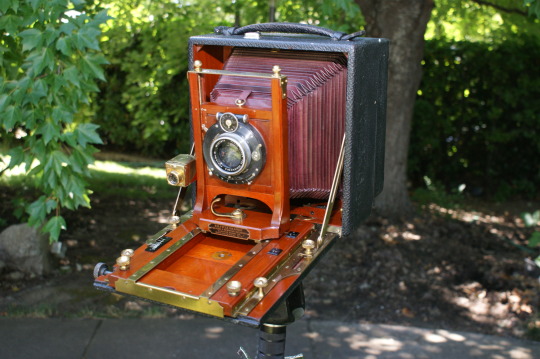
5x7” RB Cycle Graphic, with f6.8, 8 ¼” Goerz Dagor lens.
I recently received a 5x7” RB Cycle Graphic outfit, which included several very interesting lenses, including an f:6.8, 8 ¼ –inch Goerz Dagor, a wide-angle 6 ½ x 8 ½” Bausch & Lomb Zeiss Protar V, with a Supplemental wide-angle bed, and an early Goerz telephotographic tube with a 3 ½-inch Goerz tele-negative lens installed.
The Cycle Graphic was first introduced in 1900, with a reversible back, in five formats from 3 ¼ x 4 ¼” to 8x10”. An accessory focal plane shutter was made available for each format in 1902. The design was made sturdier in 1904, and included front shift and a double-swinging back, and a dropping bed, in both 5x7” and 6 ½ x 8 ½” formats. The Revolving Back Cycle Graphic was introduced in 1907, in four formats from 4x5” to 8x10”, and was made through 1922. The 8x10” model was only available with the reversible back, and it and the 4x5” model were discontinued in 1920. The 6 ½ x 8 ½ RB Cycle Graphic was used as the basic camera in the panoramic Cirkut No. 8 outfit.
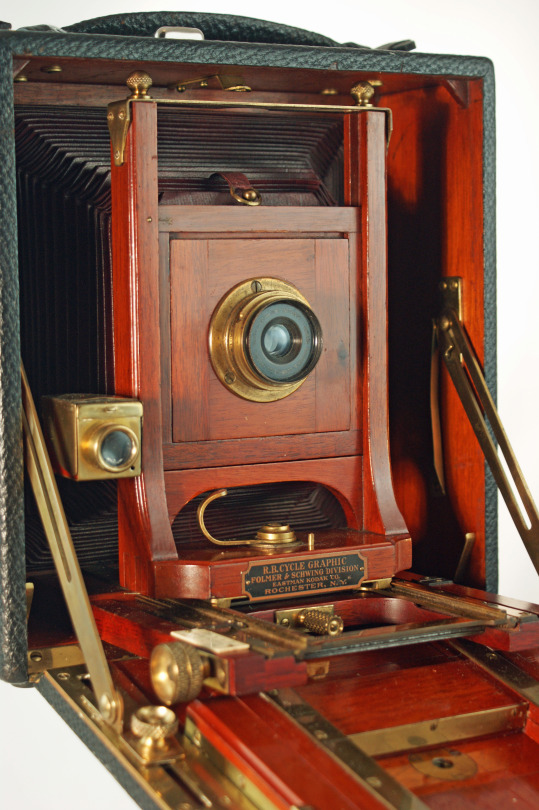
5x7 RB Cycle Graphic with B&L Zeiss Protar Series V wide-angle lens and supplementary WA bed.
The Cycle Graphic Supplemental wide-angle bed was introduced in 1912, and, with consideration of the low serial number on the camera, 1912 or 1913 are good, educated guesses for the year of manufacture. This RB Cycle Graphic also came with a revolving back Graflex focal plane shutter, which facilitates the use of barrel lenses, such as the Protar Series V.

5x7” Folmer & Schwing Auto Graflex Focal Plane Shutter attachment for revolving back.
The 1913 Graflex Catalog described the RB Cycle Graphic as being the foremost camera of its type:
“For the technical worker the Revolving Back Cycle Graphic is particularly valuable, as its ridged construction and accurate adjustment make it indispensable for those engaged in scientific research, involving the application of photography. … the rigidity of the Graphic – due to the most careful, accurate and thorough construction ever incorporated in photographic apparatus – is still a Graphic feature which will bear particular emphasis, and is one of the features which has given the Graphic its prestige with scientific and advanced photographic workers.”
“To allow the use of long focus lenses, ample bellows capacity is provided. The front runs out on telescopic framed tracks, reinforced by angle-brass guides with milled head binding screws, which lock the bed rigidly in place. The extension tracks being in the form of frames allow extra large lens space when closed. The construction of these tracks affords a wider base for the lens support and prevents any lateral or oscillating movement, thus rendering the Cycle Graphic particularly adaptable for tele-photo and other extremely accurate work.”
Such description of the Cycle Graphic may well have influenced the photographer who originally purchased this outfit, as they were clearly interested in good optics, and wide-angle and telephoto photography.
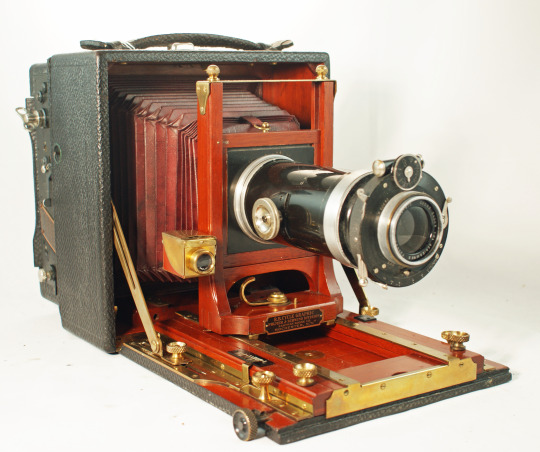
5x7 RB Cycle Graphic with Goerz 8 ¼” Dagor and Goerz Xa Tele-tube and tele-negative lens.
Telephotography
I have read some about the early designs of telephoto lenses, which combined a negative lens of the photographer’s choice at the rear of the ‘tele-tube’, and used the photographer’s preferred ‘ordinary’ taking lens at the front of the tube. This is the first time that I have actually seen one of these, and have been able to experiment with it, so I will be concentrating on this telephoto. This tube came with two adapting rings that screw onto the front of the tube, to receive the positive lens. One of these rings, marked “Compound” fits the Compound shutter of the Dagor lens. The other ring is marked “Barrel” and must have been meant for a barrel lens, perhaps a faster lens, which is no longer present. I tried several barrel lenses in this ring, and found a Kodak Anastigmat #31, 5 ½-inch lens fits, but this focal length seems to be too short to combine effectively with the 3 ½-inch negative lens. The rule-of-thumb appears to have been that the focal length of the negative lens should be about half, or less than half, of the focal length of the positive lens.
The idea of using a negative component at the rear of a tube to magnify the image produced by a positive component in front has long been used in telescopes, and both Galileo Galilei, in 1610, and Johannes Kepler, in 1611, developed refracting or dioptric telescopes based on this principle. In 1834, Peter Barlow designed a diverging rear lens component for telescopes which is still in wide use today. However, it was not until the end of the nineteenth century that this principle was applied to photography.
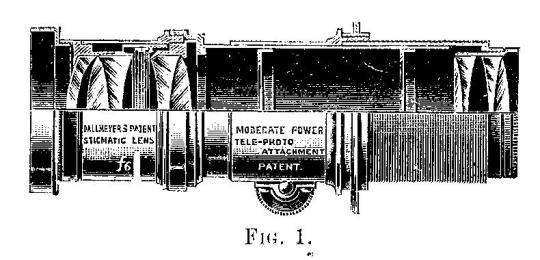
T. R. Dallmeyer Telephoto lens of the 1890s
In 1891, Thomas R. Dallmeyer of England, A. Duboscq of France, and Dr. Miethe of Germany developed telephoto lenses for photography. The designs by Dallmeyer and Miethe were nearly identical, but, communicating through the British Journal of Photography, they could not establish who had primacy, and so no patent was granted. Dallmeyer introduced an improved version, the Simple Telephoto Lens, in 1892, and was granted a patent. By 1896, the design had been improved to include a well-corrected positive lens, and a better-corrected negative lens made up of a pair of doublets. It was recognized early-on that magnifying the image also magnified the positive lens’s optical aberrations. It was eventually recognized that it was very difficult to correct a negative lens for use with a wide range of different positive lenses, and by 1899 Dallmeyer had introduced the Adon Telephoto lens, which had a dedicated set of lenses, so that the aberrations could be fairly well balanced throughout the system. This lens still allowed the separation to be adjusted, and this adjustment away from an optimally corrected position introduced increasing aberrations.
However, the telephoto attachment for an ordinary positive taking lens remained popular among photographers, because of its great versatility. Because the separation between the positive and negative lens could be adjusted, when used on a camera with generous bellows extension, it was possible for the photographer to adjust the lens to provide the image magnification and field of coverage desired. That is, decreasing the separation between the lenses increases the focal length and magnification of the image. This also required increasing the bellows extension to bring the new image into focus. The photographer could also increase the image magnification by swapping-out the negative lens with one of a shorter focal length, thus increasing the ratio between the two lenses, and so increasing the power of the telephoto, also thereby increasing the image scale, but at a shorter bellows extension. The field of coverage can be increased by extending the bellows, and then re-focusing the image by adjusting the separation between the positive and negative lenses.
In theory, if the telephoto lens allows for sufficient adjustment, and the camera allows for sufficient bellows extension, any magnification up to ‘infinity’ can be reached. Small changes in the separation result in large differences in the focal length of the telephoto lens, and larger differences bellows extension. The brightness of the image diminishes by the square of the distance (extension), and so the length of exposure soon becomes inconvenient.
In practice, especially after the introduction of well-corrected anastigmatic lenses during the first decade of the 1900s, some photographers were able to produce successful images with magnifications up to 40 times the size of the image produced by using the ordinary taking lens alone. Telephotographs made of mountain peaks twelve miles away or more could show such details as rocky ridges and snow patches not visible to the naked eye at that distance.
This capacity for magnification also proved useful for studio portraiture, providing images with better perspective, and without the disproportionate size of hands and legs caused by using a normal lens close to the sitter. And the telephoto lens also proved useful for taking close-up, one-to-one or greater macro images of near objects, such as flowers, insects or birds.
The Telephotographic Attachment in Use.
Early authors of telephotography how-to books clearly put a lot of thought into how to use the telephoto lens. Here are some of their helpful hints.
It is important to use a long lens hood in order to reduce internal reflections in the lens, and thus reduce flare and fogging, which can veil the image in a dull gray. This was a major source of disappointment in the early years.
When the separation between the positive and negative lenses is equal to the focal length of the positive lens, then the image produced is the same size as that produced by the positive lens alone. As the separation is decreased, the magnification is increased, in theory to infinity. The minimum ‘useful’ separation is found by subtracting the focal length of the negative from the focal length of the positive. That is, for a telephoto system made up of an 8 ¼ inch positive and 3 ½ inch negative, 4 ¾ inches is the minimum separation at which, in theory, an image can be formed. In reality, dealing with very large magnifications is impractical, due to the rapid loss of the intensity of the light.
The magnification of a set-up can be calculated by dividing the camera bellows extension by the focal length of the negative lens, and adding 1. Some early authors measured the bellows extension from the ground glass to the face of the lens mounting flange, while others measured from GG to the rear surface of the negative lens, so this is at best an estimation.
When the separation between the positive and negative lens has been adjusted to produce the desired magnification, the equivalent focal length of the telephoto system can be found by multiplying the focal length of the positive lens by the magnification.
To find the effective aperture of a telephoto system, multiply the aperture (f stop) set on the positive lens by the magnification. That is, if the positive lens is set to f/11, and one is working at a magnification of 4 diameters, the effective aperture of the telephoto system is f/44.
The above recommendation about exposure can be compared to the recommendation that the telephotographic exposure can be calculated by multiplying the exposure that would be given with the positive lens alone by the square of the magnification. That is, if the positive-lens exposure called for is 1 second at f/11, and the telephoto is set to produce 4 diameters of magnification, the photographer would square the magnification of 4 (4x4 = 16) and multiply the exposure by the product: 16 x 1 second = 16 seconds. An exposure of 1 second at f/11 is a very close equivalent to 16 seconds at f/45.
The authors writing during the early part of the 20th century were using plates and films that were overly sensitive to ultra violet and blue light, and so, when using a telephoto lens on a hazy day, they cautioned against overexposure due to the inherent luminosity of the atmosphere. Yellow filters were recommended, such as the Wratten K2, K3 and G filters.
Whether a specific telephoto lens set-up will cover your film depends on the focal lengths of the positive and negative lenses, the aperture of the positive lens (because the positive lens diaphragm is in front, stopping down can cause vignetting), the magnification, and the clear diameter of the negative lens. The circle of illumination is smaller at lower magnifications, and quickly increases as the magnification increases. Generally speaking, to cover a 4x5-inch film with a magnification of 3 diameters, a negative lens of 3-inches focal length would be needed, and at 4 or 5 magnifications, a negative of 2 ½-inches should work. To cover 5x7-inch format at a magnification of 3 diameters, a negative lens of 3 ½” inches would be needed.
Conclusion
One can see how the ambitious photographers of the 1890s and 1910s would have been intrigued by the idea that they could use their cameras to reach out into the distance, and bring in fine detail not otherwise available to the eye. And one can see how the actual results might not have measured up to the expectations. The surprising versatility of a lens that could be configured to provide a lens of the local length and magnification desired, without excessive bellows extension or the large mass of a non-telephoto long lens, is attractive. The calculations needed, the careful measurements, the rigorous set-up on a stout tripod, the issues with haze, flare, and camera vibrations during long exposures, and so forth, no doubt led to many disappointments. Before the relatively well-corrected anastigmat lenses, such as the Goerz Dagor, were commonly available, the lenses used were likely to be the fairly fast Rapid Rectilinear and a Petzval type portrait lens, and the negative lenses would magnify their uncorrected aberrations as well as their images. As lens correction improved, and as the telephoto lens was simplified to the fixed-focal-length type, telephotography may have become less intriguing, but it has certainly become easier, and more widely appreciated.
References.
Dallmeyer, Thomas. R. 1899. Telephotography, an Elementary Treatise on the Construction and Application of the Telephotographic Lens. William Heinemann, London. Reprinted by Scholar Select.
Early Photography, Telephotography http://www.earlyphotography.co.uk/site/entry_L72.html
Kinglake, Rudolph. 1951. Lenses in Photography, The Practical Guide to Optics for Photographers. Case-Hoyt Corporation, for Garden City Books, Garden City, New York.
Kingslake, Rudolph.1989. A History of the Photographic lens. Academic Press Inc., Harcourt Brace Jovanovich, Publishers, Boston, San Diego, New York, Berkeley, London, Sydney, Tokyo, Toronto.
Kinglake, Rudolph, 1992. Optics in Photography. SPIE Optical Engineering Press, Bellingham, Washington, USA.
Lan-Davis, Cyril E. 1912. Telephotography. George Routledge & Sons Limited, London. E. P. Dutton & Co., New York.
Lockett, Arthur. 1925, 1947. Camera Lenses. Sir Isaac Pitman & Sons, LTD. London. [Pages 68 – 82.]
Marriage, Ernest. 1901. Elementary Telephotography, Iliffe & Sons, London
Pierce Vaubel RB Cycle Graphic Revolving Back Cycle Graphic, Folmer & Schwing Mfg. Co. (piercevaubel.com)
Schriever, J. B. editor, 1909. Complete Self-Instructing Library of practical Photography. Volume VI At-Home Portraiture, Flashlight, Interiors, Lenses. American School of Art and Photography, Scranton, PA. [Volume VI, Chapter XLII Telephotography.]
Wheeler, Captain Owen, 1910. Modern Telephotography, A Practical Manual of Working Methods and Applications. Ross LTD., Optical Works, Clapham Common, London.
Wikipedia, History of Photographic lens Design
https://en.wikipedia.org/wiki/History_of_photographic_lens_design
4 notes
·
View notes
Text
Murder, Mormons, and Monarchy: the Story of King Strang
Here is my attempt at relaying the story of King Strang, a story I heard from a professor of mine. He had lived on Beaver Island for most of his life and the story of King Strang is a huge part of local history. I’ve lived on the island for a few summers but didn’t grow up there. I wrote this without consulting Wikipedia or any outside information so this is just based off my memory.
King Strang was a Mormon priest who wanted to break away from the branch of Mormonism he was part of in Michigan in the 1800s. He became a leader and amassed a large following. To maintain his power he took his followers to an island in the middle of Lake Michigan and claimed it as his own. On the island he named himself the king, making him the only true monarch in North America.
At first people more or less accepted him as king. After all, they followed him as a church leader, and in the first few years he wasn’t terrible. They established a town on the north end of the island and named it after St. James, which is still the name of the town today.
At some point Strang decided he wanted to build the first ever paved road on the island, which is pretty ambitious considering the terrain. He got people to do it, though it was likely via threat of force and something more akin to indentured servitude rather than true employment. They started paving the road starting from the town of St. James right down the middle of the island.
Things sort of went crazy after a while, which is to be expected an island where it snows for half the year. The island itself is full of northern water snakes (nonvenomous but have a very powerful bite) and poisonous plants, dangerous terrain including bog mats, rip currents, and forests so dense even a well-trained forester doesn’t dare go out alone. Conflict between the Mormon Strang Squad and the non-Mormons living on the island increased. They sabotaged each other’s boats, got into fights, etc., a la Wild West. Alcoholism and murder.
Strang claimed the island was the “promised land” for him and his Mormons, and used his religious authority to get what he wanted. Eventually people got tired of his power hungry reign. Some of the Mormons switched sides and left Strang’s church/cult, either by well and truly deserting or staying within the community but not truly believing.
Because they were on an island they depended on shipping almost everything over from the mainland via boat. One night, King Strang was hanging out at the harbor telling people what to and just generally being his controlling regal self. A group of assassins surrounded him, hiding behind boulders and on boats, and shot him. He died and fell into the harbor.
It wasn’t a terrible loss, most of the inhabitants of Beaver Island didn’t mourn Strang’s death. Those who did were family and a few of his remaining loyal followers. Pretty much right after he died the Mormons left, those who stayed on Beaver Island stopped following the Mormon church. They even stopped construction on the paved road. The island was then taken over by Irish immigrants escaping religious persecution.
Today, the Irish culture dominates modern Beaver Island, it could be said that the non-Mormon Irish got their victory over the Strang Squad. The road was named King’s Highway after King Strang. It’s still the only paved road on the entire island and stops after just a few miles. Strang is treated more as a joke than anything. Other aspects of local history such as the sanctity of Native American burial grounds and Feodor Protar are revered.
Here’s the official Wikipedia page for King Strang!
https://en.wikipedia.org/wiki/James_Strang#Coronation_and_troubled_reign_on_Beaver_Island
#oral tradition#oral history#weird history#history#mormons#united states history#story time#michigan#irrelevant#irish#irish history#sort of#I apologize if any of this sounds disrespectful but BI people really don't like the mormons#wild west#1800s#mid 1800s#mid 19th century#19th century#king strang#local legend#local legends#ask me about weird BI stories
3 notes
·
View notes
Text
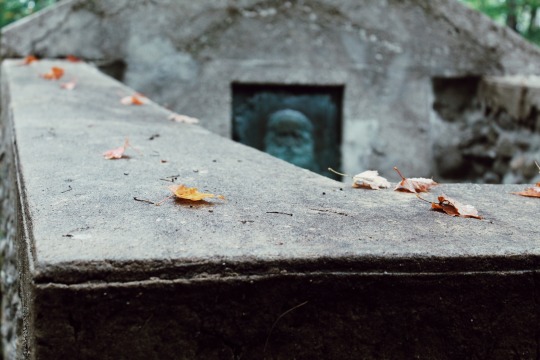




Protar’s Tomb
The resident unlicensed physician here in the 1890’s and early 1900’s, he lived alone and off his land as much as possible. He was so beloved by the townspeople on the island that they all contributed to erecting the tomb where he now resides when he passed in the 1920’s.
1 note
·
View note
Photo

UK 1991
13 notes
·
View notes







